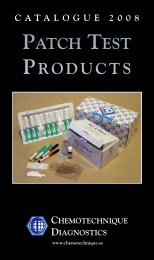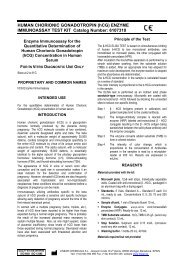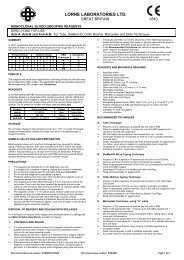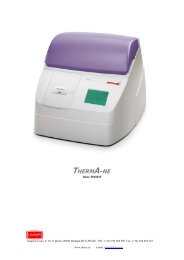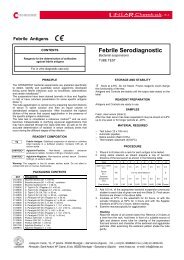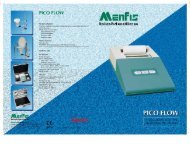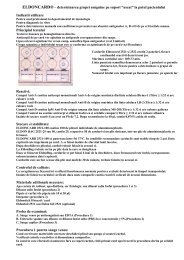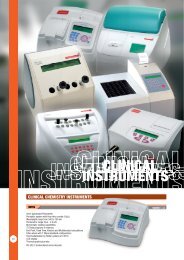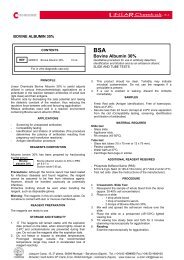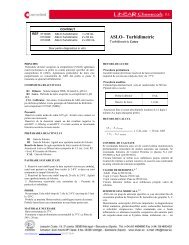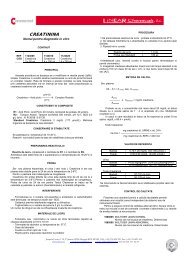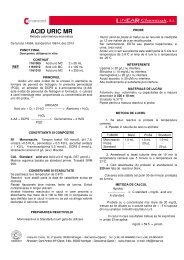Toxo-Latex - Balmed
Toxo-Latex - Balmed
Toxo-Latex - Balmed
You also want an ePaper? Increase the reach of your titles
YUMPU automatically turns print PDFs into web optimized ePapers that Google loves.
<strong>Toxo</strong>-<strong>Latex</strong>REF27400052740010CONTENTS<strong>Toxo</strong>-<strong>Latex</strong><strong>Toxo</strong>-<strong>Latex</strong>50 Tests100 Tests<strong>Toxo</strong>-<strong>Latex</strong>Determination of antibodies anti-<strong>Toxo</strong>plasmaSLIDE TESTFor in vitro diagnostic use onlyPRINCIPLE<strong>Toxo</strong>-<strong>Latex</strong> Test is a rapid slide agglutination procedure,developed for the direct detection of antibodies anti-<strong>Toxo</strong>plasma inhuman serum.The assay is performed by testing a suspension of latex particlescoated with antigenic extract of <strong>Toxo</strong>plasma gondii againstunknown samples. The presence or absence of a visibleagglutination, indicates the presence or absence of anti-<strong>Toxo</strong>plasma antibodies in the sample tested.REAGENT COMPOSITIONR <strong>Toxo</strong>-<strong>Latex</strong> Reagent. Suspension of polystyrene latexparticles coated with antigenic extract of T. gondii in abuffered saline solution. Contains 0.95 g/L of sodium azide.CONTROL + Human serum with an antibody anti-<strong>Toxo</strong>plasmaconcentration > 10 IU/mL. Contains 0.95 g/L of sodiumazide.CONTROL - Animal serum. Contains 0.95 g/L of sodium azide.Precautions: Components of different human origin have been tested andfound to be negative for the presence of antibodies anti-HIV 1+2 and anti-HCV, as well as for HBsAg. However, the controls should be handledcautiously as potentially infectious.Warning: Sodium azide may react with lead or copper plumbing to formexplosive compounds. When disposing of this product through plumbingfixtures, flush with plenty of water. Require Safety Data Sheet for moreinformation.Personal protection: Wear suitable protective gloves.REFREFPACKAGING CONTENTS2740005 kit 50 tests.1x1.7 mL <strong>Toxo</strong>-<strong>Latex</strong> Reagent, 1x0.5 mL Positive control,1x0.5 mL Negative control, 9 Test cards and 1 x 50 disposablepipettes.2740010 kit 100 tests.2x1.7 mL <strong>Toxo</strong>-<strong>Latex</strong> Reagent, 1x0.5 mL Positive control,1x0.5 mL Negative control, 17Test cards and 1 x 50 disposablepipettes.STORAGE AND STABILITYStore at 2-8ºC. Do not freeze. Frozen reagents could changethe functionality of the test.Reagent and Controls are stable until the expiry date stated on thelabel.REAGENT PREPARATIONReagent and Controls are ready to use.SAMPLESFresh, clear serum.Samples should be stored at 2-8ºC up to one week or for longerperiods at –20ºC.−−−−I.1.2.3.4.5.6.7.II.1.2.3.MATERIAL REQUIREDAutomatic pipettes.Saline solution (0.9% NaCl, only for semi-quantitativeprocedure).Mechanical rotator, adjustable at 100 r.p.m.Laboratory alarm clock.PROCEDUREQualitative TestBring the test reagents and samples to room temperature(Note 1).Resuspend the antigen vial gently. Aspirate dropper severaltimes to obtain a thorough mixing.Place 1 drop (50 µL) of the sample under test into one of thecircles on the card. Dispense 1 drop of positive control and 1drop of negative control into two additional circles.Add 1 drop (25 µL) of <strong>Toxo</strong>-<strong>Latex</strong> Reagent to each circle nextto the sample to be tested.Mix the contents of each circle with a disposable pipette whilespreading over the entire area enclosed by the ring. Useseparate pipettes for each sample.Rotate the slide slowly by means of a mechanical rotator (100r.p.m.) for a period of 5 minutes (Note 2).Observe immediately under a suitable light source for anydegree of agglutination.ReadingNonreactive: Smooth suspension with no visible agglutination,as shown by negative control.Reactive: Any degree of agglutination visible macroscopically.Semi-quantitative TestFor each specimen to be tested place with an automaticpipette 50 µL of 0.9% saline solution into each of the circles ofa card. Do not spread diluent.To circle one add 50 µL of specimen to the saline solution and,using the same tip, mix the saline solution with the sample byrepeated aspiration and expulsion of the fluid and transfer 50µL of the mixture to the saline solution in the second circle.Continue with the 2-fold serial dilutions in a similar manner upto the sixth circle, and discard 50 µL from this circle . Finalsample dilutions will be: 1:2, 1:4, 1:16, 1:32, 1:64.Test each dilution as described in steps 3-7 for the QualitativeTest.
NOTESReadingSame as in Qualitative Test. The titer of the specimen isreported as the highest dilution that shows reactivity. The nexthigher dilution should be negative.If the highest dilution tested is reactive repeat the test startingwith a preliminary 1:16 dilution. Use a 1:50 dilution of negativecontrol in 0.9% saline solution to replace the 0.9% salinesolution in the new 2-fold dilution series.QUALITY CONTROLPositive and negative controls should be run daily following thesteps outlined in the Qualitative Test, in order to check the optimalreactivity of the reagent.The positive control should produce clear agglutination. If theexpected result is not obtained, do not use the kit.EXPECTED VALUESThe presence of agglutination indicates an antibody concentration ≥10 IU/mL.CLINICAL SIGNIFICANCE 1-4<strong>Toxo</strong>plasmosis is an infectious disease, caused by the protozoanparasite <strong>Toxo</strong>plasma gondii. Acquired toxoplasmosis is usuallyasymptomatic and benign. Adults, depending on the geographicalarea and age, would contain antibodies in more that 50% of cases,being protected to a new infection. In its congenital form may bedevastating, causing mental retardation, ocular disease, and deathin newborn.Infection in pregnant women acquires a special significance as theparasite may enter the fetal circulation through the placenta andcauses congenital toxoplasmosis especially during the firsttrimester of pregnancy. The consequences can be spontaneousabortion and prematurity with visceral and neurological symptomsin the fetus.___1.2.1.2.3.4.5.6.The sensitivity of the test may be reduced at low temperatures.The best results are achieved at 15-25ºC.Delays in reading the results may generate in over-estimationof the antibody present.SOURCES OF ERRORBacterial contamination of controls and specimens as well asfreezing and thawing of the <strong>Toxo</strong>-<strong>Latex</strong> Reagent may lead tofalse positive results.Traces of detergent in the test cards may give false positiveresults. Wash used cards first under tap water until reactants areremoved and then with distilled water. Allow to dry in air, avoidingthe use of organic solvents as they may impair the special finishon the slide.The <strong>Toxo</strong>-<strong>Latex</strong> Reagent must not be used beyond its expirydate because a prolonged storage can affect the sensitivity of thesuspension.REFERENCESJacobs L. ADV Parasitol. 11: 631 (1973).Feldman HA. Hosp. Practice. 4: 64 (1969).Ruoss CF at al. The Journal of Obstetrics and Gynecology ofthe British Commonwealth. 79: 1115 (1972).Lunde MN at al. The Journal of Parasitology. 53 (5):933(1967).Kwantes W at al. Journal of Clinical Pathology. 25: 359 (1972).Young D.S. Effects of Drugs on Clinical Laboratory Tests, 4 thed. AACC Press (1995)._−__−−ANALYTICAL PERFORMANCESThe analytical sensitivity has been adjusted to detect more than10 IU/mL. The assay is calibrated against the 3 rd InternationalStandard for anti-<strong>Toxo</strong>plasma (WHO).Diagnostic sensitivity: 92%.Diagnostic specificity : 95 %.Prozone effect: Up to 200 IU/mL. Occasionally a prozone effectmay be observed with strong positive sera. Therefore in thesecases where a suspected case of toxoplasmosis gives a negativeresult, the test should be repeated using 1/5 serum dilution inNaCl 9 g/L.Results obtained with this reagent did not show significantdifferences when compared with reference reagents. Details ofthe comparison experiments are available on request.The hemoglobin (



